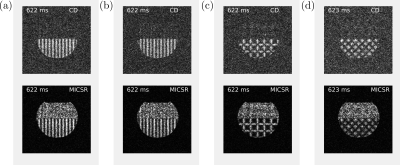3630
An Off-Resonance Insensitive Orthogonal CSPAMM Sequence (ORI-O-CSPAMM)1Department of Electrical Engineering, Pontificia Universidad Católica de Chile, Santiago, Chile, 2Biomedical Imaging Center, Pontificia Universidad Católica de Chile, Santiago, Chile, 3Millennium Nucleus for Cardiovascular Magnetic Resonance, ANID - Millennium Science Initiative Program, Santiago, Chile, 4Philips, Cincinnati, OH, United States, 5Department of Radiology, Cincinnati Children’s Hospital Medical Center, Cincinnati, OH, United States, 6Department of Radiology, Pontificia Universidad Católica de Chile, Santiago, Chile
Synopsis
We propose the Off-Resonance Insensitive Orthogonal CSPAMM sequence (ORI-O-CSPAMM). ORI-O-CSPAMM allows the acquisition of a CSPAMM grid in half of the acquisition time, removing off-resonance effects during the tagging preparation. Additionally, ORI-O-CSPAMM allows Magnitude Image CSPAMM Reconstruction (MICSR), which improves the tagging contrast through the cardiac cycle and remove spurious phases gained during the readout.
Introduction
Tagging MRI has been extensively used to assess cardiac function quantifying tissue motion and strain [1]. Complementary SPAtial Modulation of Magnetization (CSPAMM) is a tagging sequence in which two complementary SPAMM images [2] cancel the relaxed component of the magnetization from the tagging information and improve the taglines contrast [3]. However, CSPAMM is prone to off-resonance artifacts generated during the tagging preparation and readout [4], and due to the increased acquisition times, limits its usage for clinical applications.In this work, we propose the Off-Resonance Insensitive Orthogonal-CSPAMM sequence (ORI-O-CSPAMM), which combines the benefits of Orthogonal-CSPAMM (OCSPAMM) [5] with Off-Resonance Insensitive CSPAMM (ORI-CSPAMM) [4] to acquire two complementary images that that are compatible with Magnitude Image CSPAMM Reconstruction (MICSR) [6] principles to obtain a 2D grid. The proposed ORI-O-CSPAMM sequence removes off-resonance artifacts and reduces the acquisition time in half to obtain 2D grid comparing to CSPAMM, while maintaining the improved tagging contrast. The proposed ORI-O-CSPAMM were compared with CSPAMM, ORI-CSPAMM, and O-CSPAMM.
Methods
ORI-O-CSPAMM combines two orthogonal and complementary SPAMM preparation pulses (O-CSPAMM), where the position encoding gradient has been divided into two parts separated by a 180° refocusing pulse (ORI-CSPAMM), as shown in Figure 1. The ORI-CSPAMM, O-CSPAMM and the proposed ORI-O-CSPAMM sequences were implemented on a 1.5T Achieva system (Philips, Best, The Netherlands) and compared with CSPAMM sequence.A phantom consisting of a bottle filled with the same parts of water and vegetable oil was scanned to test and compare the four sequences. The images were acquired using a multi-shot Turbo-Field-Echo sequence with the following parameters: Echo-Train-Length (ETL) of 7, acquisition matrix of 160×119, reconstruction matrix of 160×160, field of view of 175×175 cm2, tag-spacing of 17.5 mm, constant flip angle of 25°, and TR/TE of 7.0/3.4 ms. In ORI-OCSPAMM, tagging gradients 1/√2 times weaker were applied in the directions X+Y and X-Y to achieve a tagging pattern with 17.5 mm of spacing in the directions X and Y.
Reconstructed images using complex-difference and MICSR are presented at different times after the trigger for all the acquisition sequences to show off-resonance effects and tagging persistence. A comparison between the mean signal between complex-difference and MICSR images obtained from ORI-CSPAMM and ORI-O-CSPAMM is also shown. The mean value was estimated inside a ROI and normalized before the image combination as described in [6].
Results
In Figure 2, the images of the phantom for a trigger-delay-time around 47 msec (the delay time changes slightly depending on the duration of the SPAMM prepulse) are presented. CSPAMM images were affected by off-resonance artifacts at the water and fat interface, which generated a horizontal shift in the taglines (Fig. 2a). In contrast, using ORI-CSPAMM the off-resonance artifacts were corrected (Fig. 2b). With ORI-CSPAMM, an orthogonal grid was obtained, but artifacts were present in the water of the complex-difference image due to long T1 and T2 values, and in the MICSR image, the grid was no longer visible (Fig. 2c). Finally, with ORI-O-CSPAMM, off-resonance effects were corrected, and proper complex-difference and MICSR images were obtained (Fig. 2d). Figure 3 shows the same images presented in Figure 2 but with a trigger-delay-time of 622 msec. The fat signal disappeared due to short T1 times, while the water grid was still visible.Figure 4 shows the normalized mean signal of the complex-difference and MICSR images obtained using ORI-CSPAMM and ORI-O-CSPAMM. The ROIs used to estimate and normalize the mean signal are presented in Figure 4a and 4b. ORI-O-CSPAMM showed slightly higher signals over different trigger delay times than ORI-CSPAMM overall.
Discussion
ORI-O-CSPAMM showed excellent results in correcting the off-resonance effects and reducing the acquisition time of CSPAMM to acquire 2D grids and it is compatible with MICSR reconstruction. The low SNR observed in the phantom data (Figures 2 and 3) can be explained by the size of the phantom, which was considerably smaller than the head coil used during the acquisition.The artifacts present in the water part of the complex-difference O-CSPAMM image were probably generated by long T1 and T2 values and wrong spoiling of the transverse magnetization, which lead to a grid without sinusoidal modulation. However, further experiments have to be performed.
The expected signal behavior of MICSR is better appreciated in the fat due to the lower T1 (see Fig. 4d), where lower signals than the complex-difference are found at short trigger times, but higher signals are found at the end. Differences in the hand-made ROIs could explain the mismatch found between the signal of images obtained using ORI-CSPAMM and ORI-O-CSPAMM sequences.
Conclusion
We proposed the improved tagging sequence ORI-O-CSPAMM and demonstrated the results in phantom data. ORI-O-CSPAMM allowed the acquisition and reconstruction of CSPAMM and MICSR grids corrected from off-resonance effects in half acquisition time than CSPAMM, which can have potential to clinical applications.Acknowledgements
The authors thankfully acknowledge the financial support of the ANID Ph. D. Scholarship 21170592 as well as the following projects and institutions: ANID-FONDECYT 1181057, and ANID-Millennium Science Initiative Program - NCN17_129.References
[1] Chitiboi, T., & Axel, L. (2017). Magnetic resonance imaging of myocardial strain: A review of current approaches. Journal of Magnetic Resonance Imaging, 46(5), 1263–1280. https://doi.org/10.1002/jmri.25718.
[2] Axel, L., & Dougherty, L. (1989). MR imaging of motion with spatial modulation of magnetization. Radiology, 171(3), 841–845. https://doi.org/10.1148/radiology.171.3.2717762.
[3] Fischer, S. E., McKinnon, G. C., Maier, S. E., & Boesiger, P. (1993). Improved myocardial tagging contrast. Magnetic Resonance in Medicine, 30(2), 191–200. https://doi.org/10.1002/mrm.1910300207.
[4] Reyhan, M., Natsuaki, Y., & Ennis, D. B. (2014). Off-resonance insensitive complementary SPAtial Modulation of Magnetization (ORI-CSPAMM) for quantification of left ventricular twist. Journal of Magnetic Resonance Imaging, 39(2), 339–345. https://doi.org/10.1002/jmri.24154.
[5] Wang, H., Kadbi, M., Kotys, M., Ersoy, M., Chatzimavroudis, G. P., Setser, R. M., Alshaher, M., Fischer, S. E., & Amini, A. A. (2011). Orthogonal CSPAMM (OCSPAMM) MR tagging for imaging ventricular wall motion. Proceedings of the Annual International Conference of the IEEE Engineering in Medicine and Biology Society, EMBS, 535–538. https://doi.org/10.1109/IEMBS.2011.6090098.
[6] NessAiver, M., & Prince, J. L. (2003). Magnitude image CSPAMM reconstruction (MICSR). Magnetic Resonance in Medicine, 50(2), 331–342. https://doi.org/10.1002/mrm.10523.
Figures



